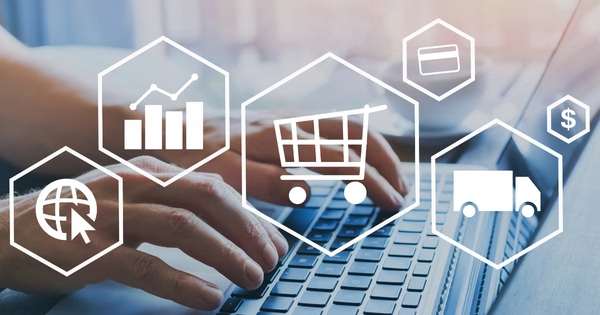There’s been a real shift this year: the volume of online retail in B2B has exceeded that of B2C (Gartner). And this trend is likely to intensify thanks to marketplaces, which represent the best driver of sales among professionals: 70% of new marketplaces in the coming years will focus on B2B!
Digital retail in B2B in 2022 will be worth some $7 billion (Frost & Sullivan). If this incredible sum doesn’t grab your attention, it’s equivalent to +20% (19.6%, to be precise) and equates to the increase in online B2B sales in the first quarter of 2022 in France. B2C, meanwhile, is standing still, with a drop of 15% (Fevad).
The marketplace model provides companies with new opportunities. This “revolution” is happening gradually: professionals are slowly embracing this solution. They’re not used to working in this way, even though they already make a significant number of their personal purchases on marketplaces. It also takes time for a company to internally approve a change on this scale.
Changing habits
Launching a marketplace means embarking on a new way of managing a market; to do this, a company needs to adapt the way in which it works. You will probably need to review your stock and catalog management with the (virtuous) aim of automating them.
For instance, Alstom worked with IZBERG to launch StationOne, the first marketplace for railway operators. Wheels, bearings, motors, suspensions, cables, screws, cameras, personal protective equipment: StationOne provides all the necessary material for maintenance, installation, repairs, servicing and even training. The site streamlines the supply chain by working directly with a wide range of suppliers and by facilitating the identification of parts, the ordering process and the organization of deliveries.
Total provides us with another example: Click & Buy is an internal marketplace, which facilitates invoicing, especially for small amounts (C-class purchases). The main benefits for the group: faster processing times and time savings for its employees.
In addition to spare parts and invoices, you can also “trade” events online, as GRDF has done with its service marketplace, known as Dej’Tour’. The site encourages all group employees to sign up for internal lunches and discussions throughout the year.
Developing a service offering
Developing a B2B marketplace is also an opportunity to consider the specificities of the market and to demonstrate that you can respond to them with a real sense of service. Your professional clients have needs that don’t exist in B2C: quote management and deferred payment methods (credit, leasing with the option to purchase, long-term leasing, credit insurance, etc.), along with automatic invoicing and batch delivery management. A marketplace makes it possible for you to do this, while also offering a range of additional functionalities: from a deferred payment solution to the use of a virtual IBAN to limit the risk of any errors with manual entry.
The model also facilitates the management of access and rights (including approval by the ordering party, for instance) because in B2B, the person who’s buying isn’t necessarily the person who’s paying! Lastly, your site can support your company’s international expansion by automating the choice of language and compliance with local regulations.
Expanding the target market
Who wouldn’t want to reach new clients by launching on new markets that have previously been limited in scope?
Launched by IZBERG in 2017, Suez’s Organix marketplace connects sellers of organic waste (fruit, oil, sugar, lactose, etc.) with biogas plants with the aim of transforming this waste into energy.
It’s a win-win for all the project’s stakeholders. This reduces waste, protects the environment, creates a new business and opens up the market to all, overcoming an “ultra-local” issue that was previously resolved solely by word of mouth. The Organix marketplace already has 200 sellers and 140 buyers and more than 300 tons of waste have been sold online.
In addition to providing an opportunity to develop a new business model, a marketplace makes it possible to:
- launch an additional offering, as we are increasingly seeing in the health sector. Major financial organizations are creating marketplaces that offer the leasing or purchase of medical equipment for professionals; the purchase process includes financing options, whether for long-term leasing or leasing with the option to purchase.
- firmly establish a business within the circular economy by refurbishing and reusing. There are many examples of this, including Backacia, Cycle Up, Waste and BeeWee, which works to give industrial spare parts a new lease of life.
A marketplace project is more business-focused than technological. That’s why IZBERG supports its clients during the early strategic analysis phase: this is a vital process to identify and prioritize the functionalities to be included in your platform’s store front.
